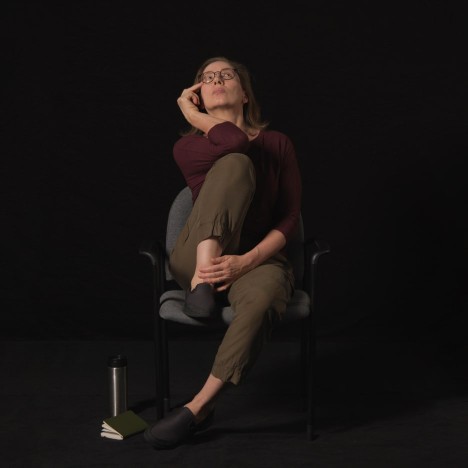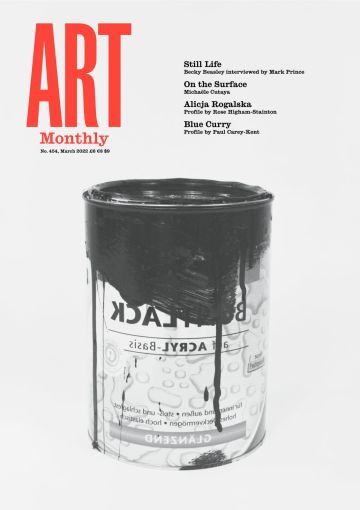Review
Andrea Fraser: This meeting is being recorded
Olivia Aherne feels the discomfort in Andrea Fraser’s confrontational anti-racism video installation

Andrea Fraser, This meeting is being recorded, 2021
In 1948, American psychologist Kurt Lewin claimed that ‘social action, just like physical action, is steered by perception’. Lewin’s centring of self-awareness in group dynamics is thought to have informed the experimental learning and research methods of Wilfred Bion and the Tavistock Institute of Human Relations (TIHR), founded in London in the 1950s. These efforts to understand the social and psychological forces underlying groups, organisations and institutions have become the focus of Andrea Fraser’s recent practice, including her latest work This meeting is being recorded, 2021, a performance-based video installation included in her solo exhibition at Künstlerhaus Stuttgart.
Projected at human scale, Fraser sits in a room within a room. Six empty chairs complete a circular formation – a group, including the artist herself. I chose to sit opposite Fraser, one chair away from another visitor so as to keep what I thought was a polite distance, but I almost immediately begin to analyse my decision, along with every subsequent alteration of my body position. Fraser’s video, a full 98 minutes in length, is an in-depth exercise in psychodynamics; it’s a live working-through of discomfort and conflict, a here-and-now exercise in analysis and reflection. The video stems from a series of recorded Zoom meetings, where a group of seven intergenerational self-identified white women – and Fraser – employed psychoanalytic group relations methods to analyse unconscious racism and its role in the propagation of white supremacy. Face to camera, Fraser painstakingly performs all seven members; each of their individual traits, tones and idiosyncrasies are performed flawlessly, almost erasing the medium through which each individual comes to be – Fraser herself.
Clenched fists, furious nodding and contorted arms and legs embody the internal frustrations, refusals and discomforts that are navigated as the group explores the means and formations of power, race, gender and age. Fraser’s decision to centre whiteness as the site of study stems from the artist’s assertion that ‘white people [should] work on our racism amongst ourselves’ and ‘disburden people of colour from the often re-traumatising task of educating white people’, but as the video demonstrates, this is not an effortless process.
As group members contend with their simultaneous privilege and sense of vulnerability, what’s exposed is the mind’s ability to defer, transfer, project, mirror, shutdown and kick back – as one woman says, ‘it’s easier to talk about politics than it is being racist’. The underlying emotions and psychological patterns and tendencies contained within group exchange offer an important, less widely explored, site for anti-racist work. By homing in on the more unconscious inclinations – tone, body language, facial expressions and kneejerk reactions – Fraser asks us to consider the nuances of guilt, shame and anxiety as they arise, forcing our efforts to address the lived reality before it further embeds itself into the socio-political and psychological structures of our time.
The digital projection of Fraser-as-group, myself as a spectator and object of projection, and my own psychological projection back onto the work creates a tight circuit of transference – its own group of relations, an infinite mirror of reflection. So what about the spaces in between, the intergroup or interorganisational? To say that Fraser performs each individual also fails to recognise the staging of the material in between; the relational qualities of the group and the relations that exist inside us, internalised. While there is a focus on the interwoven, the main focus also always comes back to the group as a whole: sub-conflicts are enacted by Fraser on behalf of the entire group, while individuals who are not actively participating in any conflicts experience it vicariously. These often highly emotional exchanges, in which the stakes are high, and which are normally hashed out in private, are here, projected into space – laying bare the charged dynamics of power and privilege. The unconscious ways in which we present ourselves, who we think we are, and how we want to be perceived by others are bought into focus, moving from latent constructions to conscious projections.
Two floors below are two of Fraser’s earlier works: Projection, 2008, and Men on the Line: Men Committed to Feminism, KPFK, 1972, 2012/14. Housed inside two parallel black box spaces, the videos actively intersect with the personal and the plural, the private and the public. Projection is based on recordings of Fraser’s psychotherapy sessions in which the artist is the patient, while Men on the Line reanimates a live radio broadcast from 1972 in which four men discuss their experiences with the contemporaneous feminist movement. All three works embark on the same methodological process of transcribing, editing and reworking scripts which Fraser then performs directly to camera. They are also all projected life-size, as if to spatially implicate the viewer. Fraser subtly attends to the formation of space and its power; for example, both This meeting and Men on the Line invite you to join the circle, while Projection positions Fraser at either end of the space, alternating between left and right – positioning the viewer in the relational space between the patient and the psychiatrist.
At a time when there is a growing awareness of the structural racism and violence that exists within institutions, and as organisations furiously undertake anti-racism training, Fraser’s exhibition cuts through, offering a sharp alternative to understanding group power dynamics and, within that, how we perceive ourselves and others around us. For Fraser, this work becomes critique in action: critique as process and critique as a verb. Viewers find themselves inside each of these three performances – confronting my astonishment, discomfort and at times disbelief while actively partaking in a performance of power and shame. For Fraser, to transform the oppressive structures and relations that invade our social systems, we must partake in their enactment in an immediate way. Not in the somewhat safer spaces of theory, but in the uneasy processes and conflicted nature of participation.
‘Andrea Fraser: This meeting is being recorded’, Künstlerhaus Stuttgart, 25 September 2021 to 27 February 2022.
Olivia Aherne is curator of exhibitions at Nottingham Contemporary.
First published in Art Monthly 454: March 2022.









